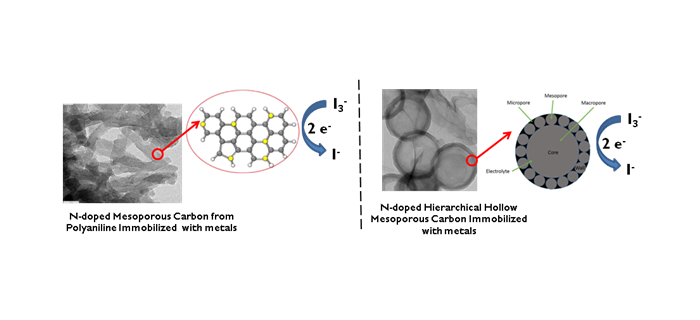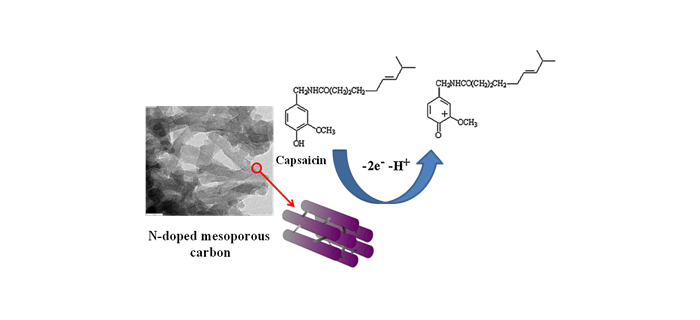วุฒิการศึกษา
- 2003 B.S. in Chemistry; Thammasat University, Pathumthani, Thailand
Grade point average: 3.77 with First Class Honors
Undergraduate Research Advisor: Associate Professor Dr. Somluck Ruangsuttinarupap
Research project: Effects of Bromine and Oxide Compound to Flammability in HDPE
- 2007 M.S. in Inorganic Chemistry; Kasetsart University, Bangkok, Thailand
Grade point average: 3.98
Graduate Research Advisor: Assistant Professor Dr. Nattamon Koonsaeng
Thesis title: Synthesis and Characterization of NiAl2O4 Spinel
- 2012 M.S.-Ph.D. in Inorganic Chemistry;The Ohio State University, Ohio, USA
Grade point average: 3.78
Graduate Research Advisor: Professor Dr. Yiying Wu
Dissertation title: Electrocatalysts toward Tri-iodide Reduction for Dye-Sensitized Solar Cells
งานวิจัย
Synthetic Inorganic Nanomaterials, Dye-sensitized Solar Cells, Flavor Sensing
Our research involves carbon-based materials with conducting and electrocatalytic properties. Our current focuses are dye-sensitized solar cells and flavor sensors. The carbon-based materials we synthesize include both ordered and hierarchical hollow mesoporous carbons with properties such as superior electrocatalytic activity, high electrical conductivity, low charge transfer resistance, and good stability.We also dope the carbon matrix with heteroatom or transition metal and characterize these by measuring properties such as electrical conductivity, electrocatalytic activity, charge transfer during electrolyte-electrode interaction process, and surface hydrophilicity. The prepared carbon-based materials are then used as the functional electronic materials for widespread application in areas such as dye-sensitized solar cells and flavor sensors. Such materials and devices have the potential to be simpler fabrication procedures, lower cost, more transparency and environmentally benign as well as higher efficiency in comparison with conventional semiconductor technology.
We utilize deep knowledge in topics of chemistry/materials science and engineering and also use advanced materials characterization techniques to design and develop new materials including devices, explore powerful characterization techniques, create novel processing/fabrication technologies as well as enable new applications.
We work with a range of Thailand and international collaborators in universities and research institutes for more specialist characterization of our devices. We welcome students with various backgrounds to join our group.
Research Areas
Electrocatalysts for Counter Electrode in Dye-sensitized Solar Cells

- The objective of the project is to study, develop, and demonstrate the feasibility of using N-doped mesoporous carbons with immobilization of Ni or Co as the CEs in DSCs.
- This project aims at the improvement of the structural characteristics of carbon material such as specific surface area, mesoporous volume, particle size uniformity, and pore size distribution (PSD) in order to make the WO2/N-HCMSC an ideal carbon electrode.
- The success of the above projects would establish a new knowledge on development of carbon-base materials as the electrocatalysts for DSC application, which will benefit many applications requiring the electrocatalyts with both high electrical conductivity and electrocatalytic activity.
- These projects are funded by Faculty of Science, Kasetsart University, Kasetsart University Research and Development Institute (KURDI), and The Thailand Research Fund (TRF)
Smart Spoon for Flavor Sensing

- The objective of the project is to study, develop, and demonstrate the feasibility
- The ultimate goal of this project is to construct a spoon consisting of mesoporous carbon electrode in order to be a versatile and mobile tool to determine the capsaicin in real food.
- The constructed smart spoon is expected to be a simple, rapid, and highly sensitive quantification tool to determine capsaicin in hot pepper samples.
- This project is funded by Kasetsart University Research and Development Institute (KURDI).
ผลงานวิจัย
- Laobuthee A; Hasin P; Koonsaeng N. NiAl2O4 Spinel Prepared from Nickel-Aluminium Complexes by using Various Nickel(II) Salts via One Pot Process. Journal.2007, 4(4), 303.
- Hasin, P; Koonsaeng N; Laobuthee A. Nickel-aluminium complex: a simple and effective precursor fornickel aluminate (NiAl2O4) spinel. Maejo InternationalJournal of Science and Technology, 2008, 2(01), 140.
- Hasin, P; Alpuche-Aviles, M. A.; Li, Y; Wu, Y. Mesoporous Nb – Doped TiO2 as Pt Support for Counter Electrode in Dye – Sensitized Solar Cells. Journal of Physical Chemistry C, 2009, 113(17), 7456.
- Hasin, P; Alpuche-Aviles, M. A.; Wu, Y. Electrocatalytic Activity of Graphene Multilayers towards I–/I3–: Effect of Preparation Conditions and Polyelectrolyte Modification. Journal of Physical Chemistry C, 2010, 114(37), 15857.
- Li Y; Hasin P; Wu Y. NixCo3-xO4 Nanowire Arrays for Electrocatalytic Oxygen Evolution.Advanced Materials, 2010, 22, 1926.
- Wang D; Li Y; Hasin P; Wu Y. Preparation, Characterization, and Electrocatalytic Performance of Graphene–Methylene Blue Thin Films. Nano Research, 2011, 4(1), 124
- Huang Z; Natu G; Ji Z; Hasin P; Wu Y; P-type Dye-Sensitized NiO Solar Cells: A Study by Electrochemical Impedance Spectroscopy. Journal of Physical Chemistry C, 2011, 115, 25109.
- Hasin P; Wu Y. Sonochemical Synthesis of Copper Hydride (CuH). Chemical Communications, 2012, 48, 1302.
- Natu G; Hasin P; Huang Z; Ji Z; He M; Wu Y; Valence Band-Edge Engineering of Nickel Oxide Nanoparticles via Cobalt Doping for Application in p-Type Dye-Sensitized Solar Cells. ACS Appl. Mater. Interfaces, 2012, 4(11), 5922.
- Hasin P; Low Temperature Synthesis of Mesoporous Cobalt(II) Carbide Using Graphene Oxide as a Carbon Source, Journal of Physical Chemistry C, 2014, 118 (9), 4726.
- Koonsaeng N; Laobuthee A; Hasin P; Controllable Synthesis of Metallo-Organic Precursor-Derived Nickel Aluminate Spinels using TEA-gel process and Morphology-Dependent Reducibility. Materials Chemistry and Physics, 2016, 182, 287.
- Hasin P; Electrochemical Milling Process to Synthesize Amorphous CoS as Highly Efficient Electrocatalyst for Tri-iodide Reduction. Solar Energy, 2016, 135, 398.
- Hasin P, Amornkitbamrung V, Chanlek N; Economical Nanocomposites of Cobalt or Nickel Species and Polyaniline-Derived N-Doped Mesoporous Carbons for Dye-Sensitized Solar Cells as Counter Electrodes. Journal of Catalysis, Submitted, 2017.
- Temcheon, P., Siriwatcharapiboon, W., Chienthavorn, O., and Hasin, P., 2018. “Highly sensitive electrochemical capsaicin sensor based on polyaniline-derived N-doped mesoporous carbon” PACCON 2018 Proceedings, Hat Yai, Songkhla, Thailand: 43-46.
- Temcheon, P. Chienthavorn, O., Sirieatcharapiboon, W., and Hasin, P., 2019. “In Situ Formation of Nitrogen Doped Mesoporous Carbon via Directly Carbonizing Polyaniline as an Efficient Electrocatalyst for Determination of Capsaicin” Microporous and Mesoporous Materials 278: 327–339.
- Itsoponpan, T., Teng, Y., and Hasin, P., 2019. “Development of Acetylcholinesterase Electrochemical Biosensor based on Sponge-like CuInS2 Microsphere-Graphene Composite for Detection of Organophosphate Pesticides” PACCON 2019 Proceedings, Bangkok, Thailand: IN18-IN23
- Pasom, Z., Lin, T-W., and Hasin, P., 2019. “Tungsten Dioxide@N-Doped Hierarchical Hollow Mesoporous Carbon for Potential High-Performance Asymmetric Supercapacitors” PACCON 2019 Proceedings, Bangkok, Thailand: IN12-IN17
- Rakspun, J., Yeh C-Y., Amornkitbamrung V., Vailikhit, V., and Hasin, P., 2019. “Molecular Doping of Reduced Graphene Oxide as Efficient Pt-free Counter Electrode for Dye-Sensitized Solar Cells” PACCON 2019 Proceedings, Bangkok, Thailand: RE8-RE14
